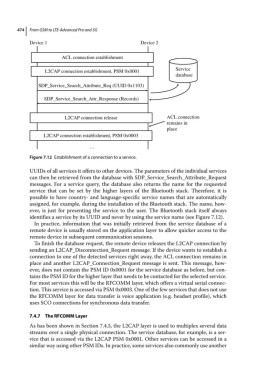Page 488 - From GMS to LTE
P. 488
474 From GSM to LTE-Advanced Pro and 5G
Device 1 Device 2
ACL connection establishment
L2CAP connection establishment, PSM 0x0001 Service
database
SDP_Service_Search_Attribute_Req (UUID 0x1103)
SDP_Service_Search_Attr_Response (Records)
L2CAP connection release ACL connection
remains in
place
L2CAP connection establishment, PSM 0x0003
…
Figure 7.12 Establishment of a connection to a service.
UUIDs of all services it offers to other devices. The parameters of the individual services
can then be retrieved from the database with SDP_Service_Search_Attribute_Request
messages. For a service query, the database also returns the name for the requested
service that can be set by the higher layers of the Bluetooth stack. Therefore, it is
possible to have country‐ and language‐specific service names that are automatically
assigned, for example, during the installation of the Bluetooth stack. The name, how-
ever, is just for presenting the service to the user. The Bluetooth stack itself always
identifies a service by its UUID and never by using the service name (see Figure 7.12).
In practice, information that was initially retrieved from the service database of a
remote device is usually stored on the application layer to allow quicker access to the
remote device in subsequent communication sessions.
To finish the database request, the remote device releases the L2CAP connection by
sending an L2CAP_Disconnection_Request message. If the device wants to establish a
connection to one of the detected services right away, the ACL connection remains in
place and another L2CAP_Connection_Request message is sent. This message, how-
ever, does not contain the PSM ID 0x0001 for the service database as before, but con-
tains the PSM ID for the higher layer that needs to be contacted for the selected service.
For most services this will be the RFCOMM layer, which offers a virtual serial connec-
tion. This service is accessed via PSM 0x0003. One of the few services that does not use
the RFCOMM layer for data transfer is voice application (e.g. headset profile), which
uses SCO connections for synchronous data transfer.
7.4.7 The RFCOMM Layer
As has been shown in Section 7.4.5, the L2CAP layer is used to multiplex several data
streams over a single physical connection. The service database, for example, is a ser-
vice that is accessed via the L2CAP PSM 0x0001. Other services can be accessed in a
similar way using other PSM IDs. In practice, some services also commonly use another

